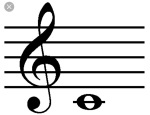Welcome to more music reader cheat sheet info!
 You’ve come into possession of my Music Reader Cheat Sheet, right? That’s excellent! Because it will help you learn the letter names of musical notes. And I mean fast.
You’ve come into possession of my Music Reader Cheat Sheet, right? That’s excellent! Because it will help you learn the letter names of musical notes. And I mean fast.
Now you can use the Cheat Sheet Definitions here to round out your musical knowledge with essential information and terminology. Take your time here to “make friends” with this additional useful information. Ready? Here we go:
Definitions and information
Treble and Bass Clefs and Staves (Plural of Staff)

The Treble Staff ~ The 5-line Treble Staff is created by use of the Treble Clef. The Treble Clef’s lovely bottom curve, above its tail, curls around the G above middle C. See my Music Reader Cheat Sheet for stay-with-you-forever info on the letter names of musical notes.
Instruments that use the Treble Staff include the guitar, ukulele, violin, flute, clarinet, trumpet, and alto and soprano voices. The piano and keyboards use the Treble Staff and the Bass Staff. See bonus info below on the Grand Staff.
But first:
 The Bass Staff ~ The 5-line Bass Staff is created by use of the Bass Clef. The Bass Clef’s two vertical dots are positioned just above and just under the F below middle C. See my Music Reader Cheat Sheet for the ultimate in essential info on the letter names of musical notes, presented in a simple way that makes it forever memorable.
The Bass Staff ~ The 5-line Bass Staff is created by use of the Bass Clef. The Bass Clef’s two vertical dots are positioned just above and just under the F below middle C. See my Music Reader Cheat Sheet for the ultimate in essential info on the letter names of musical notes, presented in a simple way that makes it forever memorable.
Instruments that use the Bass Staff include the bass guitar, double bass, trombone, tuba, and baritone and bass voices.
Line and Space Notes
 Line Notes ~ The Line Notes in music “sit” on the staff such that the line actually goes right through the middle of the musical note, instead of “sitting” in a space between the lines. This works the same whether the note is on a Treble Staff or a Bass Staff.
Line Notes ~ The Line Notes in music “sit” on the staff such that the line actually goes right through the middle of the musical note, instead of “sitting” in a space between the lines. This works the same whether the note is on a Treble Staff or a Bass Staff.
 Space Notes ~ The Space Notes in music “sit” in the spaces between the lines of the musical staff, rather than on the lines with the lines running right through the notes as above. See the difference? This works the same whether the note is on a Treble Staff or a Bass Staff.
Space Notes ~ The Space Notes in music “sit” in the spaces between the lines of the musical staff, rather than on the lines with the lines running right through the notes as above. See the difference? This works the same whether the note is on a Treble Staff or a Bass Staff.
The Focus of My Cheat Sheet: The Musical Alphabet
The Musical Alphabet ~ The Musical Alphabet has just seven letters: A, B, C, D, E, F, and G. In fact, the entire spectrum of Western harmony can be notated using only seven letters! So what happens when you get to G? Actually, just what you’re thinking: you start over at the letter A. Music is very rational in this and many, many other respects. I’ve always found that fascinating and even inspiring.
More Essential Info
 Ledger Lines ~ Ledger Lines are short horizontal lines above and below the 5-line musical staff. Musical notes are placed on, above and under Ledger Lines.
Ledger Lines ~ Ledger Lines are short horizontal lines above and below the 5-line musical staff. Musical notes are placed on, above and under Ledger Lines.
 The Grand Staff combines the Treble and Bass Staves (“staves” is the plural of staff), with the Treble Staff on top. The Grand Staff is used by pianists, keyboard players, organists, harpists, and others, like accordion players. A simple way to think of this for beginning music readers is that the Treble Staff is for your right hand, and the Bass Staff is for your left hand, while keeping in mind that this will not always be the case later.
The Grand Staff combines the Treble and Bass Staves (“staves” is the plural of staff), with the Treble Staff on top. The Grand Staff is used by pianists, keyboard players, organists, harpists, and others, like accordion players. A simple way to think of this for beginning music readers is that the Treble Staff is for your right hand, and the Bass Staff is for your left hand, while keeping in mind that this will not always be the case later.
More on Middle C
And one more: I mentioned Middle C above. It means most for pianists, keyboard players and others using the Grand Staff. But it also helps to make sense of music reading for anyone working to learn the notes on both the Treble and Bass staff. And once again, I say there is a particular beauty to the logic of it:
As critical info for pianists and keyboard players, Middle C is the C right smack in the middle of the piano keyboard. Beginning pianists sit at the piano and on the piano bench so that their bodies are aligned with the middle of the keyboard, and much beginning piano music centers around Middle C.

 Regarding note reading, Middle C resides one Ledger Line below the Treble Staff. That’s memorable, right? And here’s the beauty of that: on the Bass Staff, it resides one Ledger Line above the staff.
Regarding note reading, Middle C resides one Ledger Line below the Treble Staff. That’s memorable, right? And here’s the beauty of that: on the Bass Staff, it resides one Ledger Line above the staff.
And a Bit More from Me to You
My Music Reader Cheat Sheet details the letter names of notes on Ledger Lines closest to the staff and shows how the alphabet moves up the staff. Keep in mind as a basic rule of thumb that the alphabet moves forward as you travel up, and backward as you travel down. Additionally, Middle C, with its distinction of residing one Ledger Line below the Treble Staff and one Ledger Line above the Bass Staff, becomes a memorable anchor point as you practice determining the letter name of notes on Ledger Lines as needed.
Most of all, enjoy your musical journey. Remember to keeeeep it fun!
Musically yours,
Teresa Young
